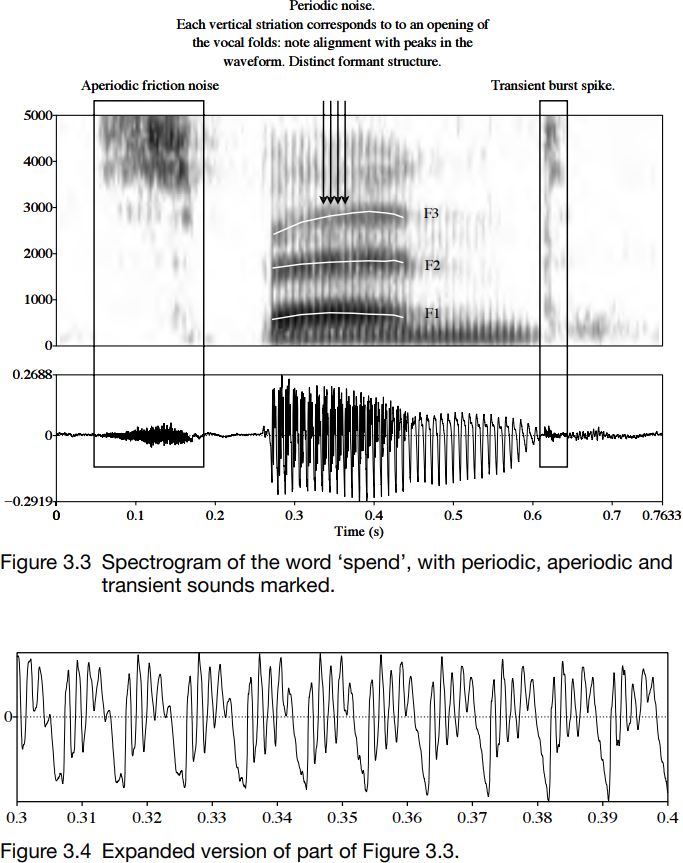
Periodic sounds
 المؤلف:
Richard Ogden
المؤلف:
Richard Ogden
 المصدر:
An Introduction to English Phonetics
المصدر:
An Introduction to English Phonetics
 الجزء والصفحة:
31-3
الجزء والصفحة:
31-3
 13-6-2022
13-6-2022
 2435
2435
Periodic sounds
Waveforms which repeat themselves are called periodic. (In reality they are not perfectly periodic, but for simplicity we will think of them as such.) In speech, periodicity is associated with the vibration of the vocal folds, so periodic waveforms are associated with voicing. Each one of the major peaks in a periodic waveform corresponds to one opening of the vocal folds. Figure 3.4 shows the waveform in the middle of the vocalic portion.

One complete repetition is called a cycle or period. There are about 10.5 cycles in Figure 3.4. This reflects the number of times the vocal folds open in the time represented. The number of complete cycles the vocal folds make in one second is called the fundamental frequency (f0); it is measured in Hertz (Hz). A frequency of 1 Hz means that there is one complete cycle per second. A frequency of 100 Hz means that there are one hundred complete cycles per second, or alternatively one complete cycle every 0.01 s (every one hundredth of a second). In the waveform in Figure 3.4, there are approximately 10.5 cycles in 0.1 s, which means the fundamental frequency in this stretch of speech is about 105 Hz.
In spectrograms, periodic signals have two important visual properties. First, there are vertical striations which correspond to the opening of the vocal folds: each time the vocal folds open and air escapes, there is a sudden increase in amplitude. This shows up in the striations in the spectrogram which line up with the peaks in the waveform. Voicing is seen in regular spikes in a waveform, and corresponding regular striations in a spectrogram.
Secondly, there are darker horizontal bands running across the spectrogram known as formants. There are three clearly visible formants in the periodic part of Figure 3.3, one centred at around 700 Hz (labelled F1), another around 1800 Hz (labelled F2), and a third one around 2800 Hz (labelled F3). There are in fact more formants, but usually only the first three are of interest.
Formants are named counting upwards. The first one is called the first formant, or F1. The next one up is called the second formant, or F2; and so on.
Formants are natural resonances. Each configuration of the vocal tract has its own natural resonance. Most of us are familiar with the idea of resonances. Imagine a home-made xylophone made of glass bottles. If the bottles are different sizes and shapes, or if there are varying amounts of water in the bottles, then when they are tapped, they will produce different notes. The big bottles will have a deeper ‘ring’ to them than the little ones, or the ones with more water in them. The vocal tract exhibits similar (though more complex) properties: when the sound wave from the vocal folds passes through the vocal tract, some parts of the acoustic signal are made louder, and some quieter. The frequencies which get amplified (made louder) are the natural resonances of the vocal tract, and are determined by its size and shape. In turn, the size and shape of the vocal tract depends on the position of the tongue, velum, lips and all the other articulators, so that different sounds of speech have different natural resonances; and in turn, they look different on a spectrogram.
To illustrate this, produce any vowel sound (say, [i:] as in ‘bee’), and then round and unround your lips. As you do this, you change the length of the vocal tract and the shape of its frontmost cavity. Acoustically, the effect of this is to change the sound that comes out, by changing the location of the formants relative to one another. When the lips are rounded, the vocal tract is a little longer; so the formants will all be a little lower.
Say the vowel [i:]; now make a glottal stop by holding your breath. If you flick your larynx gently, you will excite the first formant. You will hear a low pitched knocking sound each time you flick. If you now try this with a vowel like [a], you will hear an altogether different, higher note. This is because the shape of the vocal tract has been changed by moving the tongue and opening the jaw. If you make a vowel like [u] you will hear a lower note again.
In summary: periodic sounds in the vocal tract are caused by voicing. Periodicity is seen in a regular waveform, striations in the spectrogram, and visible formants in the spectrogram. Vowels and the sounds [w j l r m n ŋ] all illustrate these properties well.
 الاكثر قراءة في Phonetics
الاكثر قراءة في Phonetics
 اخر الاخبار
اخر الاخبار
اخبار العتبة العباسية المقدسة


